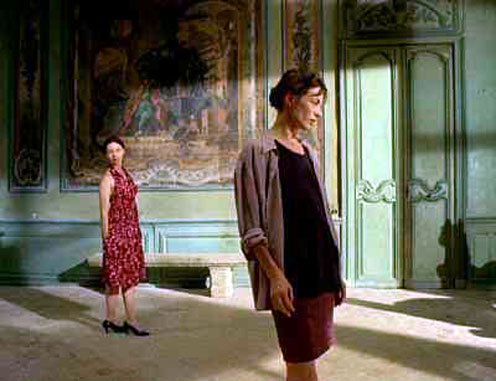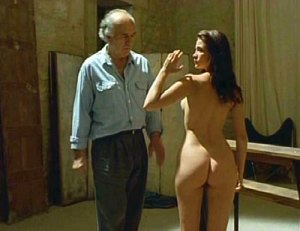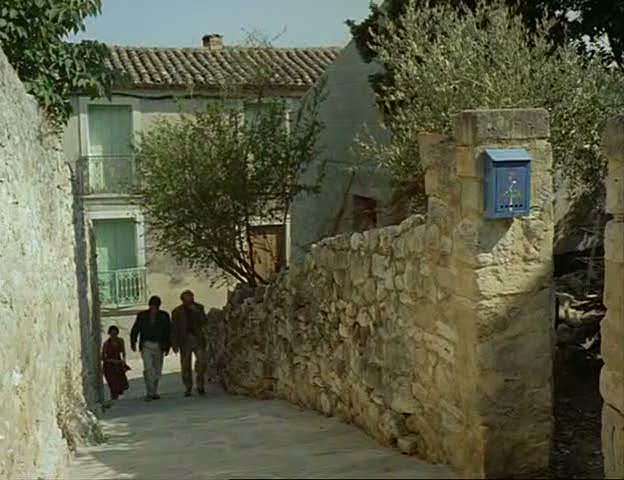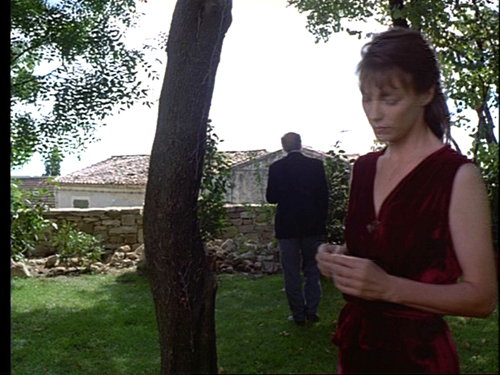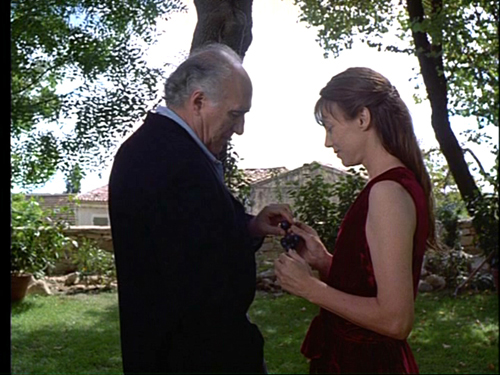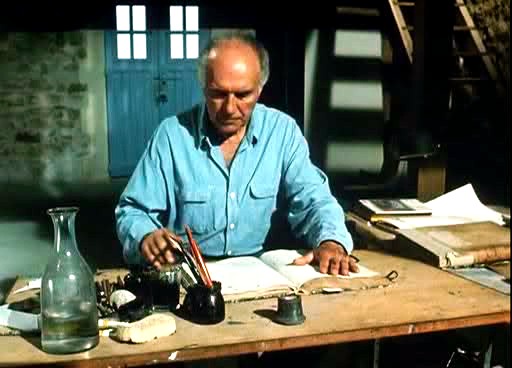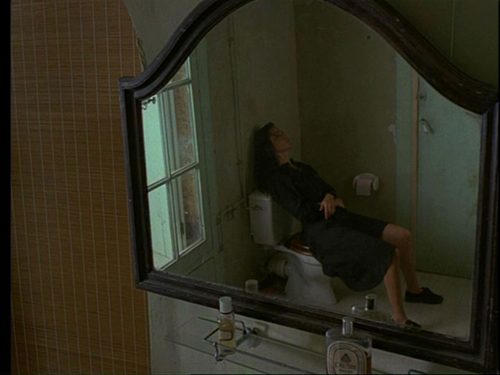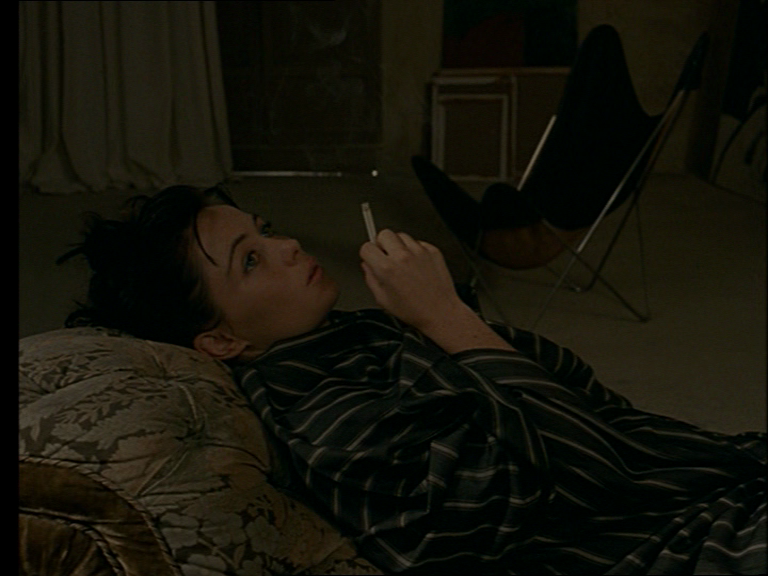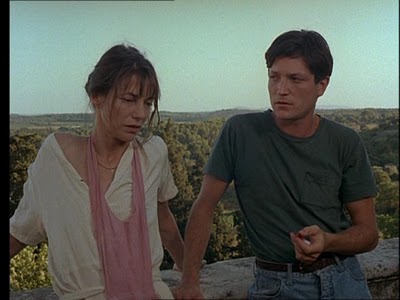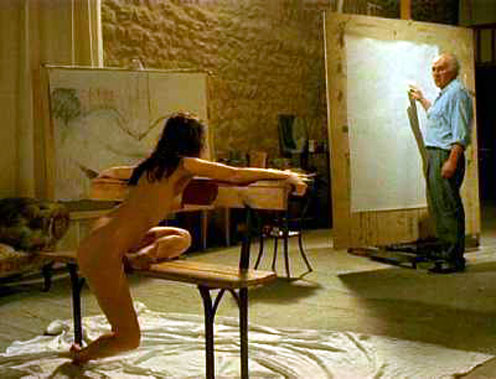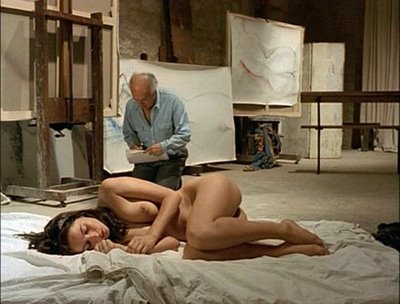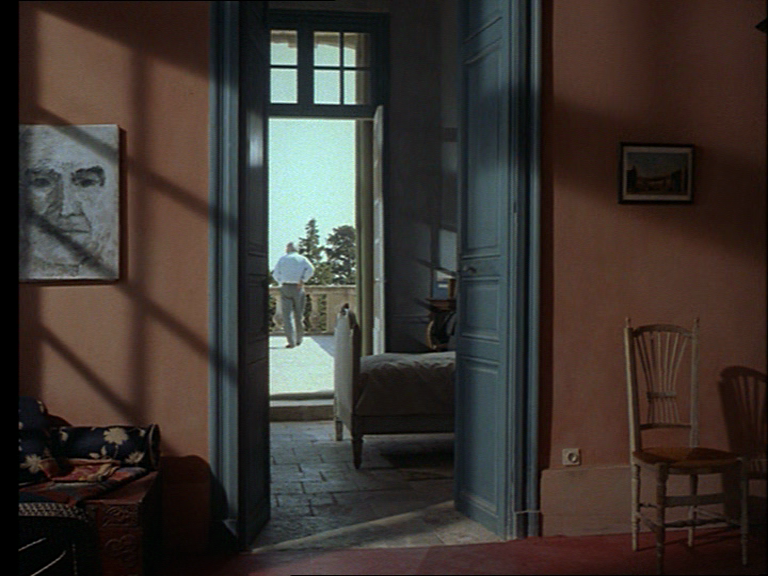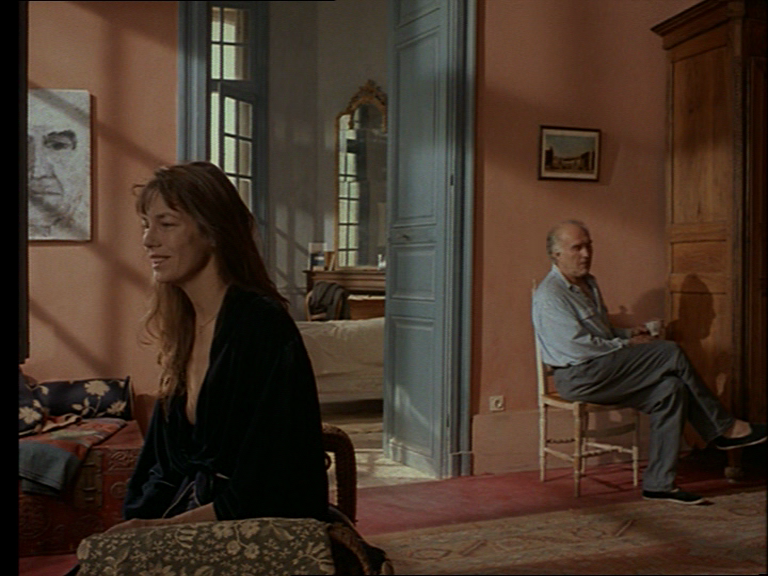From the January 31, 1992 Chicago Reader. — J.R.
LA BELLE NOISEUSE
**** (Masterpiece)
Directed by Jacques Rivette
Written by Pascal Bonitzer, Christine Laurent, and Rivette
With Michel Piccoli, Emmanuelle Beart, Jane Birkin, David Bursztein, Gilles Arbona, Marianne Denicourt, and the hand of Bernard Dufour.
Considering how rarely the achievements of art match up with the achievements of commerce, it’s a pleasure to note that Jacques Rivette’s greatest film since 1976 (the end of his most fertile and exciting period, which began in 1968) — winner of the grand prix at last year’s Cannes film festival — also turns out to be the first commercial hit of his career. A few wags have been quick to point out that this is because the beautiful lead actress, Emmanuelle Béart (best known in this country for her part as Manon in Claude Berri’s Manon of the Spring), is nude, posing as a painter’s model, for about half of the film. Maybe they’re partially right, but it also seems to me that, without compromising or diluting his artistry, Rivette has finally hit on a subject — the collective and individual struggles that produce art and the prices that have to be paid for that art — that speaks to a wide audience.
The fact that La belle noiseuse is four hours long makes this even more of an achievement — and, incidentally, confirms that in spite of some disapproving guff over the years about Rivette’s long running times being overly self-indulgent, his best films, with very few exceptions, are his longest. Duration and process are central to what his movies are about, and the longer they run the more disciplined and purposeful they usually turn out to be. As it happens, Rivette has also edited a two-hour version of La belle noiseuse for French TV, using completely different takes, and I’m not surprised to hear that there’s been no stateside interest in distributing it. In the two other cases where authorized shorter versions of Rivette films exist — Out 1 (cut from 12 hours to 4 hours) and Love on the Ground (cut from three hours to two) — the superiority of the longer version is indisputable.
For spectators unfamiliar with Rivette, La belle noiseuse provides an ideal introduction, requiring no pointers or background material. But it’s also an unusually personal and autobiographical work — even a testament of sorts — from a man whose life is so hermetic that it scarcely seems to exist at all apart from his activities as a filmgoer and filmmaker. In Claire Denis’ excellent two-hour documentary about Rivette made for French TV a couple of years ago, Bulle Ogier, the actress he has worked with most often (in 7 features out of 14) is asked at one point if Rivette regards her as a friend. She replies, quite plausibly, that Rivette has no friends, at least in any ordinary sense. Having met Rivette on numerous occasions — at screenings, festivals, and during the shooting of two of his features — I can only assume she’s right; while one can speak to him for hours about film and other arts, his timidity and his monastic air are so absolute that he calls to mind the ravaged, semimad poet Antonin Artaud.
Now in his mid-60s, Rivette seems to have mellowed since the wilder forays of his earlier work as a founding member of the French New Wave, much of which teetered on the edge of madness. The four-hour L’amour fou (1968) alternates between scenes of a theater company rehearsing Racine’s Andromache and glimpses at the tragic relationship between the play’s director and his alienated wife (Ogier), who drops out of the production in the first sequence and begins a gradual descent into madness as she festers in isolation. Like La belle noiseuse, it’s a film about the struggles and choices that have to be made between art and life.
Theater and paranoia, insiders and outsiders are also at the roots of Out 1. But in the subsequent Duelle (1975) and Norôit (1976), two parts of an uncompleted fantasy quartet, the madness might be said to be incorporated into the plots and mise en scène — that is to say, into Rivette’s visions of rival goddesses (in Duelle) and warring female pirates (in Norôit), and into imaginary universes that are more psychoanalytical projections than worlds with social or historical referents. After suffering a nervous collapse a few days into the shooting of the third feature in the quartet, Rivette resumed his career a little further down on the scale of risk and intensity, at a degree he has maintained ever since.
A sort of remake of L’amour fou, but with an alternate ending and with painting employed as a substitute for theater, La belle noiseuse might be said to recapitulate as well as reflect upon the personal history described above. In freely adapting a novella by Balzac, The Unknown Masterpiece, that I haven’t been able to locate (apparently an English translation is currently available only in England), Rivette once again ponders the choice between life and art. But where in L’amour fou it’s basically art that wins out, this film comes down squarely — if a little sadly — on the side of life. (This apparent philosophical shift is also reflected in the only significant change Rivette made in Out 1 when he recently and belatedly edited the 12-hour version into a serial for French TV: omitting a terrifying and climactic ten-minute take of Jean-Pierre Léaud, alone in his room, going to pieces.)
La belle noiseuse begins, as it ends, like a bantering 18th-century French comedy, something along the lines of Marivaux. At a village inn in the south of France, near Montpellier, a young painter (David Bursztein) sits sketching a couple of English tourists at a nearby table. A young woman (Béart) sneaks out of an upstairs room to snap his picture, and then sits down at his table and demands 10,000 francs for the photograph. It soon emerges that they’re lovers, Nicolas and Marianne, playfully pretending to be strangers. They’re awaiting the arrival of Porbus (Gilles Arbona), an art dealer who is about to introduce them to Edouard Frenhofer (Michel Piccoli), a once-famous and long-inactive painter whom Nicolas admires and who lives nearby with his wife and former model Liz (Jane Birkin) in a rambling 18th-century chateau.
After the visiting trio are welcomed by Liz, Frenhofer emerges, unshaven and unprepared for guests (“I completely forgot”), and shows everyone around his studio — a windowless former barn that reminds Marianne of a church (a significant comparison that she expands upon later). As the visitors poke around some of his old canvases, Liz alludes to his unfinished painting La belle noiseuse — his last attempt at a masterpiece, which she modeled for, abandoned a decade ago. (The title, archaic slang for “the beautiful nutty woman,” refers to Catherine Lescault, a 17th-century courtesan; in contemporary Canadian French, “noiseuse” means a woman who drives men to distraction and causes pain.) Agitated by Liz’s remarks, Frenhofer insists that the painting doesn’t exist. But later that evening, after Porbus suggests that Frenhofer use Marianne as a model and Nicolas gives his assent — Marianne is off with Liz at the time, discussing her career as a writer — he decides to make another stab at the work and asks Marianne to come back the next morning. (Porbus, who has left by this time, has already agreed to buy the painting if Frenhofer finishes it.)
Furious with Nicolas for committing her to this project without her consent (“You sold my ass”), Marianne nevertheless keeps the appointment. After an enormous amount of puttering around in his studio –rearranging diverse objects, adjusting his worktable — Frenhofer asks her to sit down and opens his sketchbook.
Throughout this leisurely opening, which takes up the film’s first hour, the sense of time and place is palpable; one can almost taste the sunlight and foliage outside and feel the dampness and darkness of the studio. Piccoli’s convincing portrait of an artist in hiding from himself, gradually nudged by himself and others into action, is little short of amazing; his comic prevarications in the studio and evasive conversational manner, showing remarkable powers of observation and synthesis, suggest the weight and complexity of an entire life behind the isolated gestures.
For most of the film’s second hour, Frenhofer executes a series of tentative sketches using both pen and brushes. Here’s where Rivette’s focus on duration and process comes in, making all the essential facts of the artist’s work — the scratch of pen against paper, the hesitations and decisions of hand and brush, the progress and revision of a design taking shape — as palpable as the sense of time and place was during the first hour. (Here and throughout the remainder of the film, the hand we see in close-up belongs to a real artist, Bernard Dufour, but the matching is done so well that the effect never looks contrived. One quite sophisticated critic, who missed the reference to Dufour in the credits, was fooled completely and assumed all of the drawing and painting was done by Piccoli.) While Rivette employs real time whenever it’s appropriate to his design, it would be quite wrong to assume that he simply lets the camera run on in the manner of Warhol; jump cuts are as essential to his sense of rhythm as long takes, and he uses both with equal judiciousness.
But more than just the artist’s work is being observed and charted. Almost an equal amount of attention is paid to the work of Marianne — tensely holding a pose, changing positions at Frenhofer’s request, improvising certain readjustments (at one point she uses a paintbrush to put back her hair), negotiating her physical discomforts in a variety of ways, and dealing emotionally with the fact that she’s being looked at constantly. After Frenhofer directs her to a dressing gown and she begins posing in the nude, the tensions of their collaboration — and the film constantly makes it clear that it is a collaboration — undergo a quantum leap. Over the course of the film, their sessions become increasingly charged with pain and passion, and it’s clear that Rivette is working from the complex interactions involved in his own art — between screenwriters, cinematographers, other crew members, and, above all, actors. (Much later in the film, a beautiful sequence is created out of Frenhofer’s efforts to find “the right angle” for viewing Marianne as she assumes “the right pose.”)
Meanwhile, Nicolas pays a visit to Liz, engaged in her own work in a separate part of the chateau, stuffing birds. She tries to assuage his worries about Marianne by assuring him that her husband is a gentleman, and he remarks that while Marianne was the one who initially needed him when they met three years ago, now he realizes that it’s he who needs her. As painter and model continue their work, Rivette cunningly keeps shifting the film’s emphasis so that sometimes we’re immersed in the sketch in progress and other times the work itself becomes a mere backdrop to the emotional state of Marianne.
At the end of the first day, we see both the older and younger couples together: Frenhofer and Liz are quite affectionate, but Marianne and Nicolas are still at loggerheads. By the time Frenhofer starts working with paint on canvas the next day, his conversations with Marianne have become much more intimate and charged — though not so intense that an affair between them seems imminent — and the stakes of this work in progress have become much higher for both of them.
For Marianne, an internal struggle has arisen between remaining a slave to Frenhofer’s vision by assuming the contorted positions he requests and striking out on her own. “Let me find my own place, my own way of moving,” she insists somewhat later, during the third hour, but her spirit of rebellion is there virtually from the beginning. Frenhofer’s struggle is a matter of differentiating will from necessity: “When I was a kid, I used to pull my toys to pieces,” he comments after placing her into a particularly difficult pose. But after he declares a little later, “I want the invisible,” he quickly corrects himself: “No, that’s not it. It’s not I who wants it, it’s the work.” Finally, he settles on a kind of mystic compromise: “It’s the line, the stroke. Nobody knows what a stroke is. And I’m after it.”
“Before the next pose, a five-minute intermission,” reads a printed title halfway through the film.
It would be imprudent to reveal much more of the plot, but a few generalities are worth bringing up:
(1) Critics who have faulted the film because they don’t find Frenhofer’s painting sufficiently accomplished or trendy seem to be confusing an overall verisimilitude about artistic process with realism. The film has a great deal to say about the real world — particularly about the roles played by art and life in relationship to one another — but very little to say about “real” painting. We never see all of Frenhofer’s masterpiece in its finished state, but we catch a brief glimpse of its bright red lower portion, enough to know that it “has blood,” as Liz remarked of one of its earlier and unfinished incarnations in which she was the model. We also see the masterpiece in an unfinished state, when it’s already clear that Frenhofer has effected some emotional bloodletting in both his wife and himself by painting Marianne over portions of another unfinished canvas of Liz in order to arrive at a “bloody” synthesis. The idea that real art hurts — and hurts not only its makers but its spectators — is central to the film. Much of the work favored by the art market — which includes critics and spectators as well as dealers and gallery owners — entails little if any pain for the artist or for anyone else, and the film points out that art that is painful usually isn’t popular. (Indeed, most of Rivette’s own career bears this out; Norôit, perhaps his most daring film, has never received a commercial run anywhere in the world.)
(2) Over the course of the film, the identity of every major character becomes redefined by the masterpiece in progress. The only one left out of this process is Nicolas’ sister Julienne (Marianne Denicourt), a character who turns up at the eleventh hour, not, apparently, to effect any significant change in the action but to give Nicolas and Marianne someone besides each other to speak to. If the film has a flaw, it would be the distracting intrusion of Julienne — though she, like each of the other five characters, is an important part of the roundelay of exchanges that concludes the film.
(3) The best scene in the film features neither nudity nor painting but a confrontational dialogue between Liz and Frenhofer in their adjoining bedrooms and on a connecting terrace in the early hours of the morning. (The terrace, perhaps not coincidentally, recalls the ramparts where life-and-death struggles are waged in Norôit.) Rivette’s musical sense of mise en scène has never been more masterful or functional in charting both the literal movements of a couple and the various stations of their “passion” (in both the carnal and Christian senses of the word). This is the scene that establishes the reasons for Frenhofer’s choice of life over art. The equivalent scene in L’amour fou showed the theater director fully entering into the madness of his wife by collaborating with her in destroying their apartment — an act conceived and executed as a 60s “art gesture,” and an emblem of the artist despairingly choosing art over life.
(4) When I suggested above that Frenhofer and Marianne collaborated in the making of his painting, I didn’t mean to imply that they were the only ones involved. Porbus, who symbolizes the art market (and specifically commissions the work); Nicolas, the disciple (and the one who offers Marianne as model); and Liz, the initial inspiration and literal background are equally instrumental, not only in generating the masterpiece but also in determining its eventual fate. (Only Julienne, the sixth cog in a five-cog machine, seems extraneous to both activities.) “I am accustoming myself to the idea of regarding every sexual act as a process in which four persons are involved,” Freud once wrote in a letter. Similarly, it would be fair to say that Rivette regards the process of making art as one in which many more people are involved than simply artist and model. That idea corresponds, in any case, to his profoundly collaborative notion of his own art. And the playful comic charades that frame Rivette’s dark meditation suggest that the life he is opting for is merely a form of protection and survival — giggles to hold back the maelstrom of nightmarish possibilities that masterpieces, including this one, unleash.


